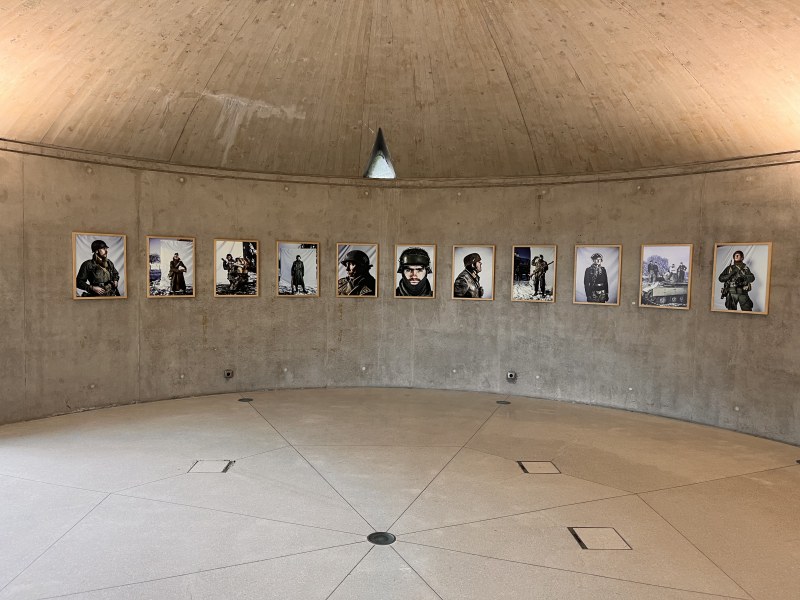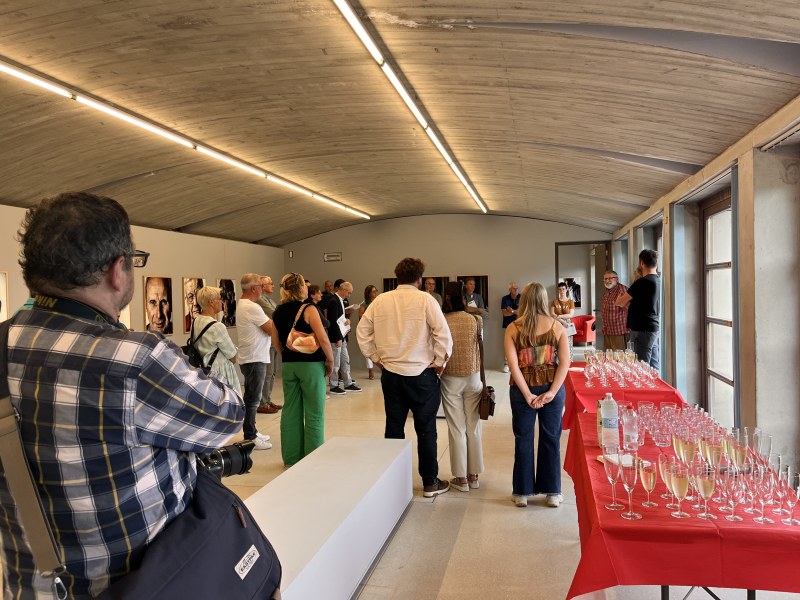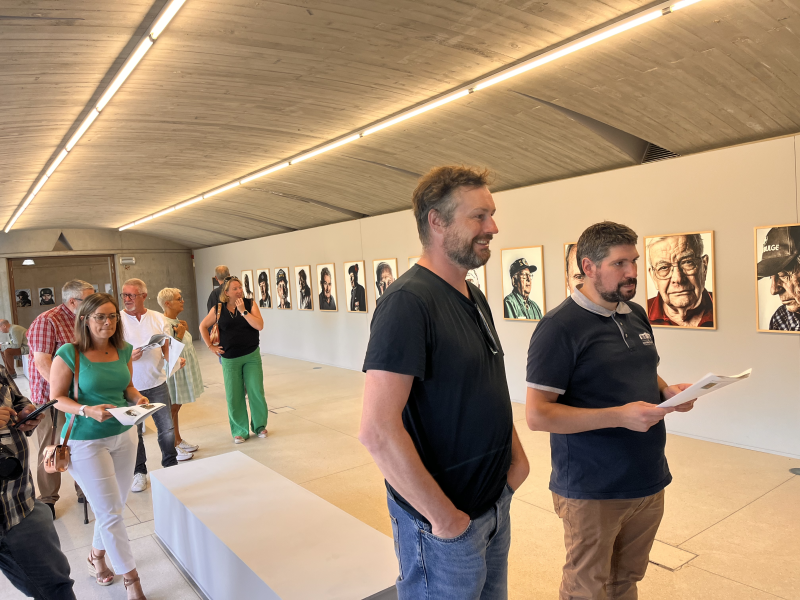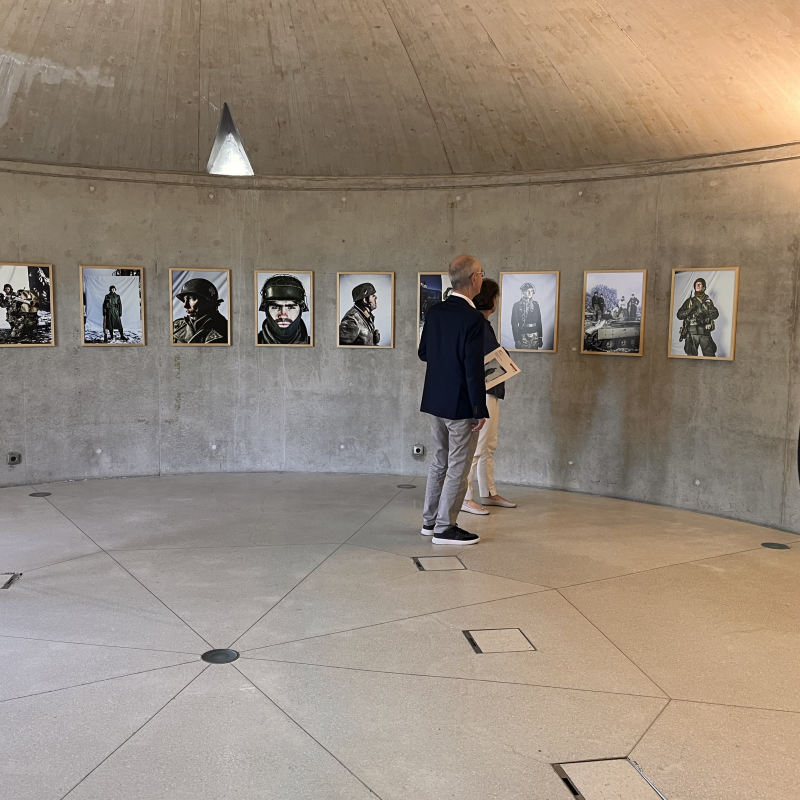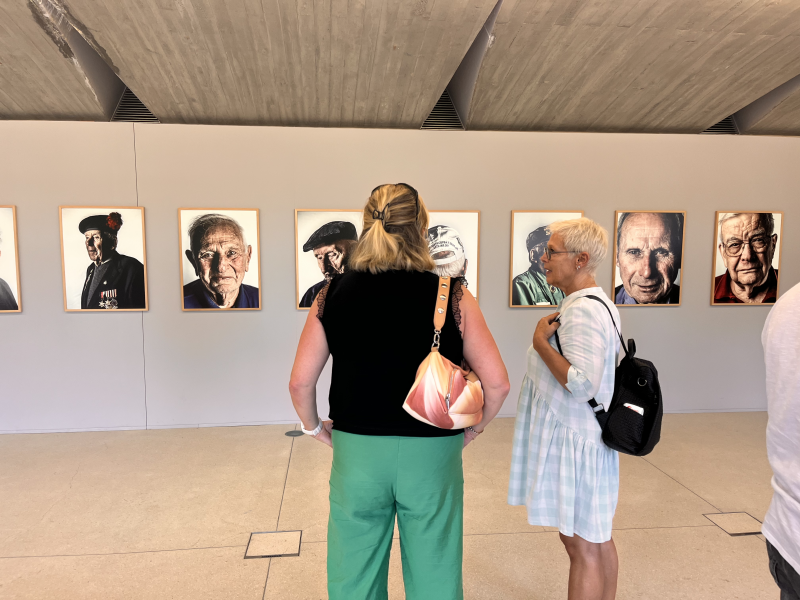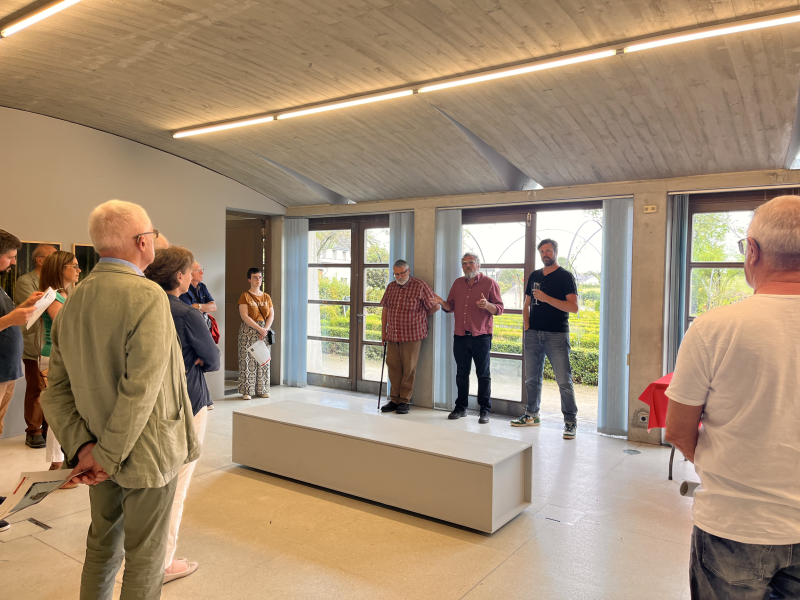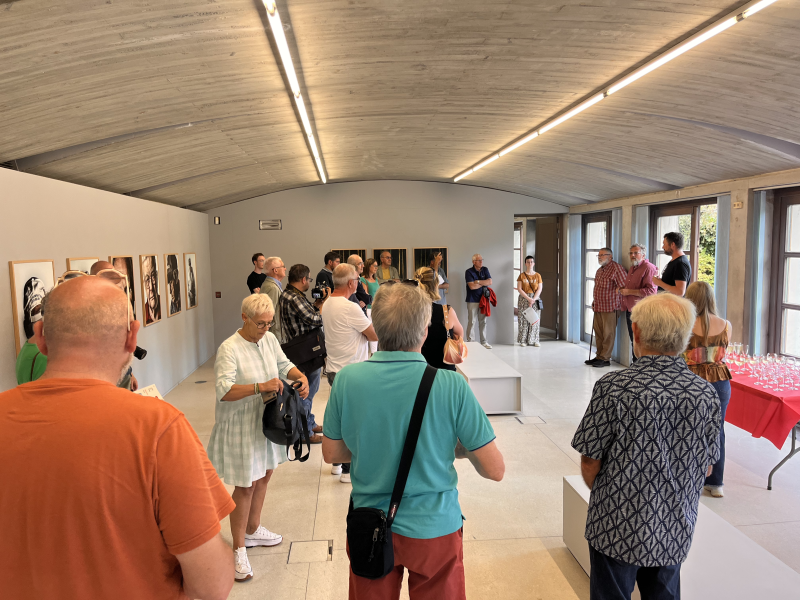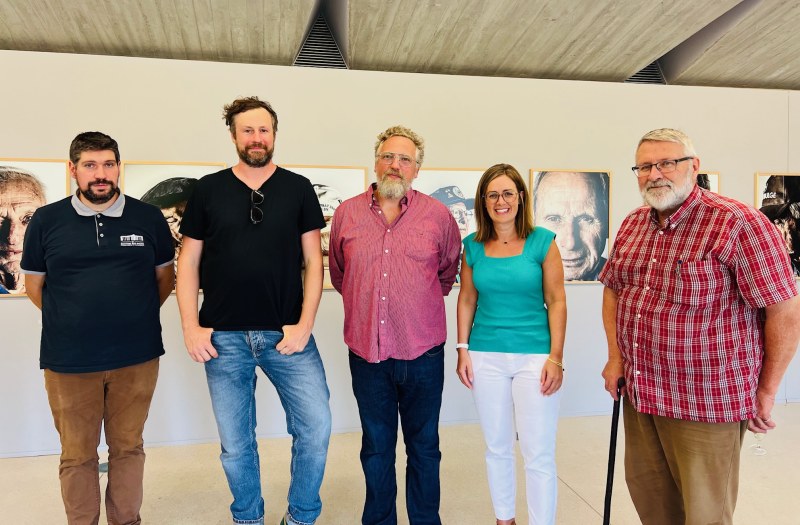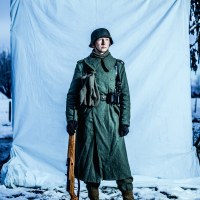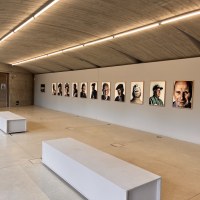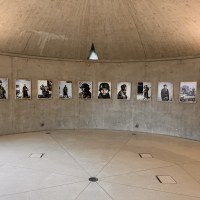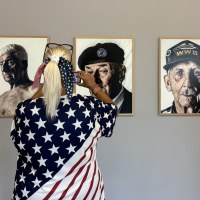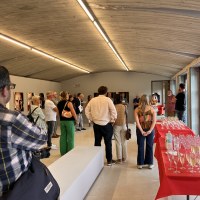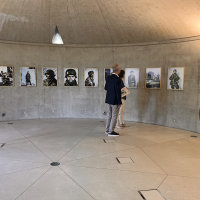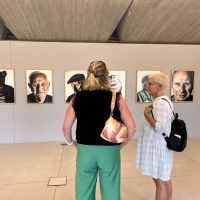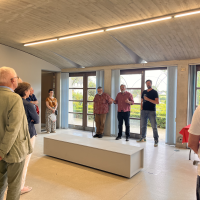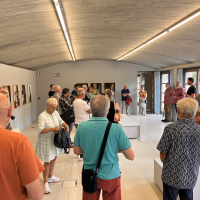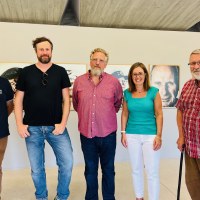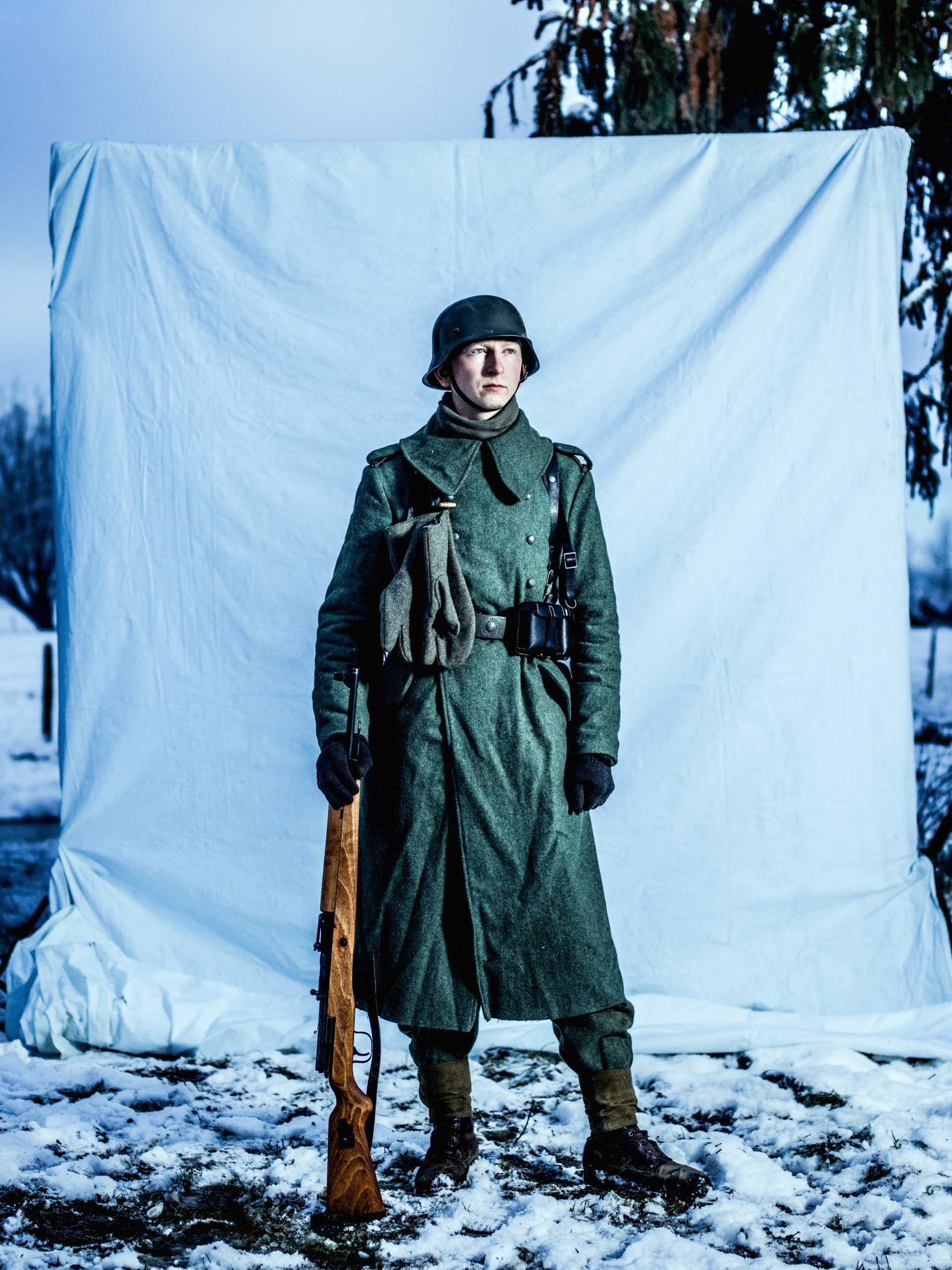L’Orangerie, espace d’art contemporain, se joint au souvenir des Commémorations du 80ème anniversaire de la Bataille des Ardennes en présentant le travail de Jelle Vermeersch qui a rencontré et photographié, en 2014, des vétérans revenus sur les lieux et des civils survivants. Ces personnes ont vécu ces événements dans leur chair et témoignent. Il a également photographié, à cette occasion, ces groupes de passionnés en uni- forme d’époque qui, à chaque commémoration, restituent ces événements dramatiques devant le public.
Lors de la bataille des Ardennes, 185 000 hommes furent tués, blessés ou portés disparus, 85 000 Américains et 100 000 Allemands. Pour les Américains, ce fut la bataille la plus dure de la Seconde Guerre mondiale dans l’histoire américaine. Mais La Bataille des Ardennes n’est pas qu’un vertigineux recueil de statistiques ou le titre d’un mauvais film technicolor de 1965. La Bataille des Ardennes est avant tout une histoire de personnes.
Jelle Vermeersch, photographe flamand, a réalisé il y a 10 ans, lors du 70ème anniversaire des Commémorations en Ardenne, une série de portraits d’anciens combattants et de victimes civiles de la région.Il y a mis en parallèle des photographies de groupes de reconstitutions et un ensemble de témoignages audio d’anciens combattants belges et britanniques mais aussi de civils francophones afin de questionner les enjeux de la commémoration et du souvenir. «Pourquoi des jeunes Allemands de 16 ans suivent-ils leur chef fou à travers les crêtes enneigées avec le feu et l’épée ? Pourquoi Doug et Michael, 20 ans, originaires de Pennsylvanie et du Montana, sautent-ils en parachute pour nous défendre dans nos forêts de pins ? Pourquoi un vieux paysan wallon garde-t-il une balle perdue dans son corps pendant des décennies alors qu’on aurait pu tout aussi bien l’enlever ? Pourquoi un comptable parisien vient-il dans un village près de Bastogne pour devenir acteur et incarner un ancien soldat américain ou allemand? Est-ce pour nous sauver des erreurs du passé ?»
Willy Dory, commissaire de l’exposition
Jelle Vermeersch est journaliste et photographe de presse. Ses photographies, allant du portrait de personnalités aux reportages consacrés au sport ou sur la campagne et ses habitants, paraissent dans des journaux et magazines tels que L’Équipe, Le Vif, Wielfried ou encore Bahamontes (qu’il a fondé en 2013). Son projet sur la Bataille des Ardennes a lui aussi été publié en 2015 dans la presse, le journal De Morgen, à l’occasion des 70 ans de commémoration. 10 ans plus tard, dans le cadre de cet événement, il le présente à nouveau, mais, cette fois, dans une exposition à L’Orangerie.
Avec ce projet photographique, Jelle Vermeersch interroge le rapport à la guerre de ses participants et des générations suivantes, lui qui est petit-fils d’un soldat belge engagé pour l’armée allemande. Vermeersch réfléchit à la manière dont l’Histoire est transmise à travers la photographie de vétérans mais aussi de personnes passionnées par les reconstitutions historiques. La composition, le choix des poses des sujets ou de l’environnement (laissant apparent le matériel technique par exemple), ainsi que le travail esthétique des ombres, des couleurs, de la neige, etc., nous incitent à nous interroger sur qui ils sont, sur leur vécu. Ainsi, les images du photographe mettent en avant l’importance de celles et ceux qui ont pris part à la guerre, mais aussi la volonté d’aller voir au-delà du « rideau », matérialisé à de nombreuses reprises dans les photographies, pour découvrir l’envers du décor de cette machinerie qu’est la guerre, mais aussi des représentations véhiculées par les images, les témoignages et les reconstitutions historiques. Aujourd’hui, et pour l’avenir, il questionne : comment faire lorsque les témoins auront disparu ? Quelles sont les bonnes manières de transmettre et de faire mémoire ? « Jouer à la guerre », en faire un spectacle en fait-elle partie ?
En 2024, Jelle Vermeersch reprend ses photographies publiées dans De Morgen pour les réorganiser dans l’espace d’exposition de L’Orangerie. Ce changement de support amène à un questionnement supplémentaire qui concerne la manière de considérer les images : d’abord destinées à la presse, deviennent-elles des oeuvres d’art une fois exposées ? Pour Vermeersch, ses photographies sont d’abord « journalistiques », sa démarche étant liée à son métier. Mais, son intérêt pour les « belles images » prend de plus en plus de place aujourd’hui dans son travail. La frontière avec l’art est finalement poreuse, d’autant que les artistes contemporains s’approprient la méthode du reportage en utilisant l’interview et la photographie comme matière de leurs oeuvres. Ils rencontrent des personnes pour donner une forme artistique à leurs histoires et à leur propre questionnement sur un sujet de société.
En utilisant la photographie comme un langage et un moyen réflexif pour envisager des questions sociétales et politiques comme la guerre, en parlant des gens pour toucher les gens, Jelle Vermeersch est proche de la démarche de l’artiste, en faisant le chemin inverse, du reportage vers l’art.
Abigaëlle Grommerch
Cette exposition aurait été idéale pour l’ouverture de la saison, consacrée à l’amour. L’amour qui a inspiré les soldats à s’engager pour la libération d’un peuple, ou amour comme fascination pour la guerre. Les deux facettes se confrontent à L’Orangerie.
Le photographe Jelle Vermeersch questionne la raison personnelle de l’enrôlement de ces soldats. Le portrait nous parle, leur visage agrandi se transforme en un paysage émotionnel. À travers le regard ou l’absence de celui-ci, ces hommes livrent un vécu. Certains se cachent derrière leur casquette de commémoration, baissent les yeux ou détournent le regard, d'autres regardent droit dans l’objectif, les yeux humides. Les cicatrices laissées par leur expérience se lisent dans leurs traits. L’imagerie médicale de la balle plantée dans le thorax contraste de froideur et n’atteint pas la force psychologique que l’on découvre dans les portraits.
De l'autre côté, dans la Rotonde s'ouvre un panorama, digne du 19ème siècle de reconstitution de bataille. Certains employés de L’Orangerie y voient même un manège de foire. Ces hommes, le regard fier, sérieux et engagé, prennent la pause devant un drap blanc, avant de se livrer à une remise en scène de bataille. Ces regards de courage et d’engouement parlent davantage d’une fascination d'une histoire passée, loin de la réalité que l’on découvre dans la première salle. Dix ans se sont déroulés depuis la prise. La déconnexion avec les horreurs commises il y a quatre-vingts ans se creuse radicalement. Le contexte actuel si polarisé offre une nouvelle lecture, une dimension nouvelle à ces photographies.
Hélène Jacques
Si vous souhaitez en découvrir davantage sur l'artiste : Interview de Jelle Vermeersch
L’Orangerie, een ruimte voor hedendaagse kunst, sluit zich aan bij de herdenking van de 80e verjaar- dag van het Ardennenoffensief met de presentatie van het werk van Jelle Vermeersch, die in 2014 terugke- rende veteranen en overlevende burgers ontmoette en fotografeerde. Deze mensen hebben deze gebeur- tenissen aan den lijve ondervonden en getuigen. Hij fotografeerde ook de groepen enthousiastelingen in historische uniformen die bij elke herdenking deze dramatische gebeurtenissen naspelen voor het publiek.
Tijdens het Ardennenoffensief werden 185.000 mannen gedood, gewond of vermist, 85.000 Amerikanen en 100.000 Duitsers. Voor de Amerikanen was het de zwaarste slag van de Tweede Wereldoorlog in de Amerikaanse geschiedenis. Maar The Battle of the Bulge is niet zomaar een duizelingwekkende verzameling statistieken of de titel van een slechte technologiefilm uit 1965. The Battle of the Bulge is in de eerste plaats een verhaal over mensen.
10 jaar geleden, ter gelegenheid van de 70e verjaardag van de herdenkingen in de Ardennen, maakte de Vlaamse foto- graaf Jelle Vermeersch een reeks portretten van veteranen en burgerslachtoffers uit de regio. De foto’s van re-enactmen- tgroepen en een verzameling audio-getuigenissen van Belgische en Britse veteranen, maar ook van Franstalige burgers, werden samengebracht om de kwesties van herdenken en gedenken te onderzoeken. “Waarom volgen 16-jarige Duitsers hun waanzinnige leider te vuur en te zwaard over de besneeuwde bergkammen? Waarom parachuteren 20-jarigen uit Pennsylvania en Montana, Doug en Michael, in onze dennenbossen om ons te verdedigen? Waarom houdt een oude Waalse boer een verdwaalde kogel tientallen jaren in zijn lichaam terwijl die net zo makkelijk verwijderd had kunnen worden? Waarom komt een Parijse accountant naar een dorpje in de buurt van Bastogne om acteur te worden en een voormalige Amerikaanse of Duitse soldaat te spelen? Is het om ons te behoeden voor de fouten uit het verleden?”
Willy Dory, curator
Jelle Vermeersch is journalist en persfotograaf. Zijn foto's, gaande van portretten van beroemdheden tot reportages over sport of het platteland en zijn inwoners, verschijnen in kranten en tijdschriften zoals L'Équipe, Le Vif, Wielfried en Bahamontes (dat hij oprichtte in 2013). Zijn project over de Slag om de Ardennen werd in 2015 ook gepubliceerd in de krant De Morgen, ter gelegenheid van de 70e verjaardag van de herdenking. 10 jaar later presenteert hij het in het kader van dit evenement opnieuw, maar nu in een tentoonstelling in L'Orangerie.
In dit fotoproject onderzoekt Jelle Vermeersch, kleinzoon van een Belgische soldaat die in het Duitse leger diende, de relatie tussen oorlog en zijn deelnemers en volgende generaties. Vermeersch reflecteert over de manier waarop geschiedenis wordt doorgegeven via de fotografie van veteranen en mensen met een passie voor historische re-enactments. De compositie, de keuze van poses voor de onderwerpen of de omgeving (onthullende technische uitrusting, bijvoorbeeld), evenals het esthetische gebruik van schaduwen, kleuren, sneeuw, enz. zetten ons aan om ons af te vragen wie ze zijn en wat ze hebben meegemaakt. Op deze manier benadrukken de foto's van de fotograaf het belang van degenen die deelnamen aan de oorlog, maar ook het verlangen om verder te kijken dan het “gordijn”, dat herhaaldelijk op de foto's verschijnt, om de andere kant van de oorlogsmachinerie te ontdekken en de voorstellingen die worden overgebracht door beelden, ooggetuigenverslagen en historische reconstructies. Vandaag, en voor de toekomst, vraagt hij zich af: wat kunnen we doen als de getuigen verdwenen zijn? Wat zijn de beste manieren om door te geven en te herinneren? Is “oorlogje spelen” en een show opvoeren daar één van?
In 2024 nam Jelle Vermeersch haar in De Morgen gepubliceerde foto's en reorganiseerde ze in de tentoonstellingsruimte van L'Orangerie. Deze verandering van medium roept een bijkomende vraag op over de manier waarop de beelden worden bekeken: zijn ze oorspronkelijk bedoeld voor de pers, maar worden ze kunstwerken wanneer ze worden tentoongesteld? Voor Vermeersch zijn zijn foto's in de eerste plaats “journalistiek”, zijn benadering is verbonden met zijn beroep. Maar zijn interesse in “mooie beelden” speelt nu een steeds belangrijkere rol in zijn werk. De grens met kunst is uiteindelijk poreus, vooral omdat hedendaagse kunstenaars zich de methode van de reportage toe-eigenen door interviews en fotografie te gebruiken als materiaal voor hun werk. Ze ontmoeten mensen om hun verhalen en hun eigen bevraging van een maatschappelijk probleem artistiek vorm te geven.
Door fotografie te gebruiken als een taal en een reflexief middel om maatschappelijke en politieke kwesties zoals oorlog te beschouwen, door over mensen te praten om mensen te raken, staat Jelle Vermeersch dicht bij de benadering van de kunstenaar, die de omgekeerde weg bewandelt, van reportage naar kunst.
Abigaëlle Grommerch
L'Orangerie, a contemporary art space, is joining in the commemoration of the 80th anniversary of the Battle of the Bulge by presenting the work of Jelle Vermeersch, who met and photographed returning veterans and surviving civilians in 2014. These people have lived through these events in their flesh and testify. He also photographed groups of enthusiasts in period uniforms who, at each commemoration, recreate these dramatic events for the public.
During the Battle of the Bulge, 185,000 men were killed, wounded or missing, 85,000 Americans and 100,000 Germans. For the Americans, it was the toughest battle of the Second World War in American history. But The Battle of the Bulge is not just a dizzying collection of statistics or the title of a bad 1965 technicolour film. The Battle of the Bulge is first and foremost a story about people.
For the 70th anniversary of the commemorations in the Ardennes 10 years ago, Flemish photographer Jelle Vermeersch produced a series of portraits of veterans and civilian victims from the region, combining photographs of re-enactment groups with audio testimonies from Belgian and British veterans and French-speaking civilians to explore the issues of commemoration and remembrance. "Why do 16-year-old Germans follow their mad leader across the snowy ridges with fire and sword? Why do 20-year-olds from Pennsylvania and Montana, Doug and Michael, parachute into our pine forests to defend us? Why does an old Walloon farmer keep a stray bullet in his body for decades when it could just as easily have been removed? Why does a Parisian accountant come to a village near Bastogne to become an actor and play a former American or German soldier? Is it to save us from the mistakes of the past?"
Willy Dory, curator
Jelle Vermeersch is a journalist and press photographer. His photographs, ranging from portraits of celebrities to reports on sport or the countryside and its inhabitants, appear in newspapers and magazines such as L'Équipe, Le Vif, Wielfried and Bahamontes (which he founded in 2013). His project on the Battle of the Bulge was also published in 2015 in the newspaper De Morgen, to mark the 70th anniversary of the commemoration. 10 years later, as part of this event, he is presenting it again, but this time in an exhibition at L'Orangerie.
In this photographic project, Jelle Vermeersch, the grandson of a Belgian soldier who served in the German army, examines the relationship between war and its participants and subsequent generations. Vermeersch reflects on the way in which history is passed on through the photography of veterans and people with a passion for historical re-enactments. The composition, the choice of poses for the subjects or the environment (revealing technical equipment, for example), as well as the aesthetic use of shadows, colours, snow, etc., encourage us to question who they are and what they experienced. In this way, the photographer's images highlight the importance of those who took part in the war, but also the desire to look beyond the ‘curtain’, which appears on numerous occasions in the photographs, to discover the other side of the machinery of war, and the representations conveyed by images, eyewitness accounts and historical reconstructions. Today, and for the future, he asks: what can be done when the witnesses have disappeared? What are the best ways of passing on and remembering? Is ‘playing at war’ and putting on a show one of them?
In 2024, Jelle Vermeersch took her photographs published in De Morgen and reorganised them in the exhibition space at L'Orangerie. This change of medium raises a further question about the way in which the images are viewed: originally intended for the press, do they become works of art once exhibited? For Vermeersch, his photographs are primarily ‘journalistic’, his approach being linked to his profession. But his interest in ‘beautiful images’ is now playing an increasingly important role in his work. The boundary with art is ultimately a porous one, especially as contemporary artists are appropriating the method of reportage by using interviews and photography as the material for their work. They meet people to give artistic form to their stories and their own questioning of a social issue.
By using photography as a language and a reflexive means of considering societal and political issues such as war, by talking about people in order to touch people, Jelle Vermeersch is close to the artist's approach, taking the opposite path, from reportage to art.
Abigaëlle Grommerch
This exhibition would have been ideal for the opening of the season devoted to love. The love that inspired soldiers to sign up for the liberation of a people, or love as a fascination for war. These two facets come face to face at L'Orangerie.
Photographer Jelle Vermeersch questions the personal reasons why these soldiers enlisted. The portrait speaks to us, their enlarged faces transformed into an emotional landscape. Through their eyes, or lack of them, these men reveal their experiences. Some hide behind their commemorative caps, lowering their eyes or looking away, others stare straight into the lens, their eyes moist. The scars left by their experience can be read in their features. The medical imagery of the bullet in the chest contrasts with its coldness, and does not achieve the psychological strength that we discover in the portraits.
On the other side, in the Rotonde, there is a panorama of battle re-enactments worthy of the 19th century. Some L'Orangerie employees even see it as a fairground merry-go-round. These men, looking proud, serious and committed, are pausing in front of a white sheet, before re-enacting the battle. These looks of courage and enthusiasm speak more of a fascination with a past history, far removed from the reality we discover in the first room. Ten years have passed since the capture. The disconnect with the horrors committed eighty years ago is radically widening. Today's polarised context offers a new reading, a new dimension to these photographs.
Hélène Jacques


